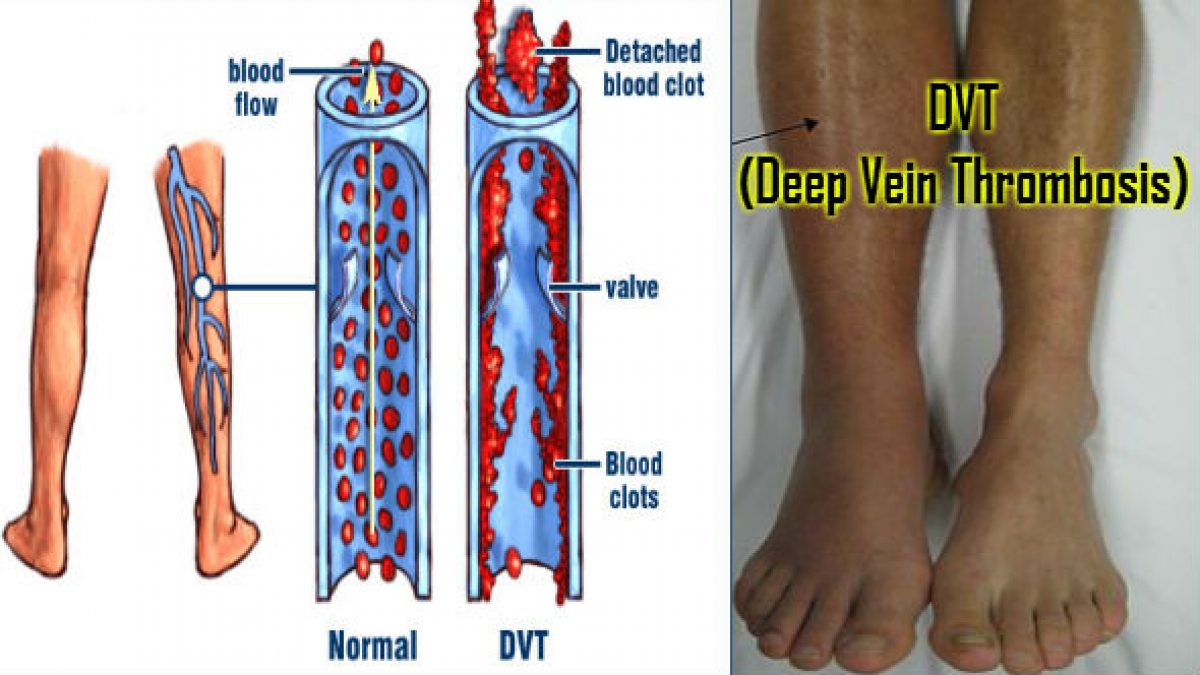Deep vein thrombosis (DVT) is a blood clot (thrombus) in a deep vein, usually in the legs. Deep vein thrombosis (DVT) is a serious condition that occurs when a blood clot forms in a vein located deep inside your
body. A blood clot is a clump of blood that is in a gelatinous, solid state. Deep vein blood clots typically form in your thigh or lower leg, but they can also develop in other areas of your body. Other names for this condition
include thromboembolism, post-thrombotic syndrome, and post-phlebitic syndrome. Clots can form in superficial veins and in deep veins. Blood clots with inflammation in superficial veins rarely cause serious problems. But clots in deep veins require immediate medical care.
These clots are dangerous because they can break loose, travel through the bloodstream to the lungs, and block blood flow in the lungs. DVT can also lead to long-lasting problems. DVT may lead to damage in the vein
and cause the leg to ache, swell, and change color.
Blood clots most often form in the calf and thigh veins, and less often in the arm veins or pelvic veins.
Symptoms of DVT include swelling of the affected leg. Also, the leg may feel warm and look redder than the
other leg. The calf or thigh may ache or feel tender when you touch or squeeze it or when you stand or move.
Pain may get worse and last longer or become constant.
If a blood clot is small, it may not cause symptoms. In some cases, pulmonary embolism is the first sign that
you have DVT.
The Patient will have to undergo an ultrasound test to measure the blood flow through the veins and help find
any clots that might be blocking the flow. Other tests, such as a venogram, are sometimes used if ultrasound
results are unclear. A venogram is an X-ray test that takes pictures of the blood flow through the veins.
- swelling in foot, ankle, or leg, usually on one side
- cramping pain in your affected leg that usually begins in your calf
- severe, unexplained pain in your foot and ankle
- an area of skin that feels warmer than the skin on the surrounding areas
- skin over the affected area turning pale or a reddish or bluish color.
People may not find out that they have deep vein thrombosis until they’ve gone through emergency treatment
for a pulmonary embolism. A pulmonary embolism is a life-threatening complication of DVT in which an artery
in the lung becomes blocked.
Complications
A major complication of DVT is a pulmonary embolism. You can develop a pulmonary embolism if a blood clot
moves to your lungs and blocks a blood vessel. This can cause serious damage to your lungs and other parts of your body. You should get immediate medical help if you have signs of a pulmonary embolism. These signs
include:
- dizziness
- sweating
- chest pain that gets worse with coughing or inhaling deeply
- rapid breathing
- coughing up blood
- rapid heart rate
Few lifestyle changes may help to prevent DVT these include keeping your blood pressure under control,
giving up smoking, and losing weight if you’re overweight. Moving your legs around when you’ve been
sitting for a while also helps keeps your blood flowing. Walking around after being on bed rest can
prevent clots from forming.
Treatment
Your provider will give you medicine to thin your blood (called an anticoagulant). This will keep more
clots from forming or old ones from getting bigger.
Heparin is often the first drug you will receive.
- If heparin is given through a vein (IV), you must stay in the hospital. However, most people can be treated without staying in the hospital.
- Newer forms of heparin can be given by injection under your skin once or twice a day. You may not need to stay in the hospital as long, or at all, if you are prescribed this newer form of heparin.
Depending on your medical history, a drug called fondaparinux may be recommended by your doctor as an alternative to heparin.
A blood thinning drug, for example warfarin (Coumadin), is often started along with heparin. Examples of other drugs that may be prescribed include rivaroxaban, apixaban, dabigatran, and edoxaban. Your doctor will decide which medicine is right for you.
- These drugs are taken by mouth. It takes several days to fully work.
- Heparin is not stopped until the drug has been at the right dose for at least 2 days.
- You will most likely take the blood thinner for at least 3 months. Some people must take it longer, or even for the rest of their lives, depending on their risk for another clot.
When you are taking a blood thinning drug , you are more likely to bleed, even from activities you have always done. If you are taking a blood thinner at home:
- Take the medicine just the way your doctor prescribed it.
- Ask the doctor what to do if you miss a dose.
- Get blood tests as advised by your doctor to make sure you are taking the right dose. These tests are usually needed with warfarin.
- Learn how to take other medicines and when to eat.
- Find out how to watch for problems caused by the drug. You will be told to wear a pressure (compression) stocking on your leg or legs. A pressure stocking improves blood flow in your legs and reduces your risk for complications from blood clots. It is important to wear it every day. In rare cases, you may need surgery if medicines do not work. Surgery may involve:
- Placing a filter in the body’s largest vein to prevent blood clots from traveling to the lungs
- Removing a large blood clot from the vein or injecting clot-busting medicines.
credits: By Dr. Rajiv Parakh, Chairman, Vascular Department, Medanta – The Medicity.





